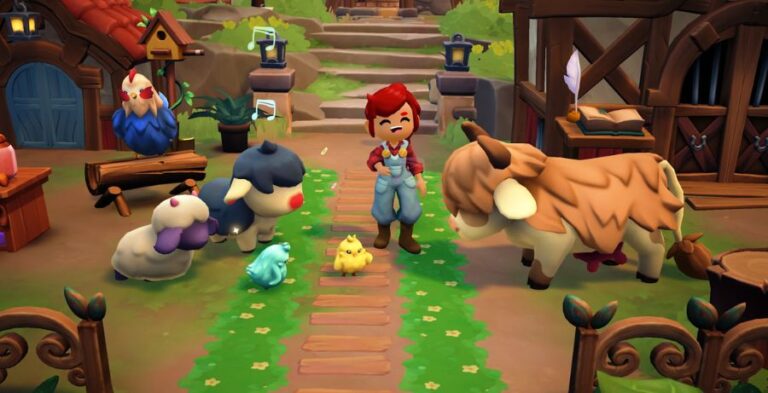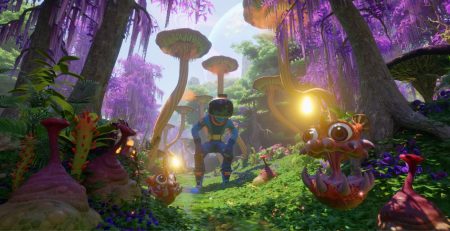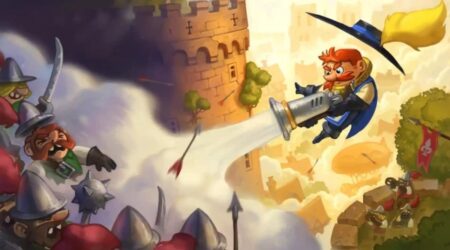Fae Farm is a fantastic and magical adventure from Phoenix Labs. Bridging the traditional cozy aesthetic and gameplay loop with some magical combat for dungeon crawling, this game puts the player at the center by offering a large number of features and systems to customize how you play, whether you’re alone or with up to three other players.
The shining star of Fae Farm is the Cozy System. I am a creative player. I want to build furniture, decorate houses, and just make everything as cute as can be. Often, however, in doing that, a screenshot is your only reward for hours of designing, which means that at some point, decorating a space becomes empty. That said, Fae Farm incentivizes players to decorate their homes, redecorate, and pay attention to what new furniture and decoration elements do for individual characters.
The Cozy System impacts your character’s health and skills with individual items adding buffs to the player. This incentivizes those who may usually just keep the bare minimum in a home to spend time decorating and investing time in this game system. By building added value to an already existing cozy game staple, Fae Farm doesn’t just incentivize players to decorate, but it also rewards players who choose to keep investing time in designing their homestead.
Additionally, this of course, impacts the farming game loop as you need resources to keep crafting. By making one system robust, Fae Farm allows the player to find reward in all the things that it connects to. But of course, there is gardening, animal caring (where you raise, care for, and breed animals), cooking, crafting, gathering loops (some of which are only accessible in dungeons), and everything connects to one another. When you add in the running day cycle and weather system, you can see how cooking becomes necessary, using different teas to cool or warm your body and different foods to boost your stamina as you gather across Azoria.
On farming, Phoenix Labs hasn’t strayed much from the existing paths set up by games like Stardew Valley. It’s simple and direct while adding one key change – no tool wheel navigation. But in Fae Farm, it’s all just one button click. Instead of needing to rotate through your tools for individual tasks, the same button is utilized across the game’s actions. This simplification allows you to perform most of the more tedious actions in Fae Farm but doesn’t include using the wand, net, or fishing pole. You also only have three bars to monitor for your character: Health, Stamina, and Mana. In addition to managing that, you must upgrade your tools to farm more materials from fewer resources or get access to new resources.

Fae Farm has a vast amount of things to do, which can be overwhelming as the day cycle ticks down and prepares you to sleep at 11pm sharp. Because of the amount that there is to do just in your homestead, tending to crops, animals, and the like, it can make it difficult to manage your priorities in any given day cycle. It also pushes the player to dedicate time to delve into dungeons when they need to as they progress in level and learn new combat skills.
By exploring dungeons in Azoria you get access to resources you can only find in them. There, you use your magic wand to fight enemies, gather resources, and explore more magical elements of the world. While the town feels very much like a slice of life, the dungeons showcase magic and interesting creature designs that show the diversity of world-building that the developers have been able to create. These dungeons connect you with the magical creatures of the world, and once you talk to the most adorable axolotl dragon I’ve ever seen, you can see where the elements of both bridge together outside thorns and mist you have to clear from the land.
Dungeons also offer an element of difficulty that pushes the player to gather more and more resources. In order to save your progression in dungeons and keep the floors open after you clear them, you need to create different seals. Each level will tell you what kind of seal you need and how many. After placing them at the entrance of a dungeon, you’ll be able to save your progress, allowing you to build on each subsequent run, a necessary element when a day cycle limits how much you can do in intervals of time. The dungeons are also the most valuable aspect for co-op play. While not many of the other functions are built with co-op in mind, but rather two people doing tasks with shared resources, the dungeons become a fun fantasy adventure when you play with someone else.
The dungeons also allow the player to see the diversity of Azoria in terms of the beautiful art and sound design that makes the game’s whimsy something fantastic. While your time in the town and your homestead is filled with adorable takes on common animals, in the dungeons, you’ll encounter enemies that look nothing like anything else in the world. In the first dungeon you run through, you fight mechanical enemies that have the same chibi aesthetic to make them the right kind of cute to fit the cozy genre even if you’re fighting.

Fae Farm’s art style is also fantastically captured in its verticality. The town is layered, moving from the water and up into the mountains. The layout of the environment allows players to take full advantage of the vertical design by not restricting what players can climb on, jump off of, swim in, or use the magic mushrooms that allow you to propel yourself up the map. While this free reign of the terrain can make things slightly chaotic when it comes to navigation, the map does allow you to find individual characters and set waypoints to find them on the map, letting you get yourself on the path you need to. Additionally, you’re able to unlock fast travel places on the map that can help streamline your travel across Azoria.
While Fae Farm has a robust gathering game loop and actually makes decorating your house well worth the investment with its cozy system, the social sim area of the game is where it’s lacking. For one, the design of the romanceable NPCs lacks the same character distinctions of those that you can’t romance. While the non-romanceable NPCs have distinguishing features not just for their genders but for their personalities, like the adventurous Cleo or the cozy and tired-looking harbormaster named Eddie, the romanceable characters look as if they were put through a filter to make them aesthetically, a blank canvas. It’s an odd choice given how diversely animated the rest of Azoria is with designs that immediately call out to character archetypes.
However, while I don’t think there is enough diversity in the romanceable characters when it comes to different performances of gender, each character has wholly unique and dynamic stories to tell when you become close to them. In that way, I couldn’t help but make myself feel like a shallow player. Once I got to see how much care was put into the narrative elements of the romanceable NPCs, their personalities began to come through. Most importantly, I found myself beginning to understand that my personal approach to romance wasn’t the way that I should approach the social sim element in Fae Farm.
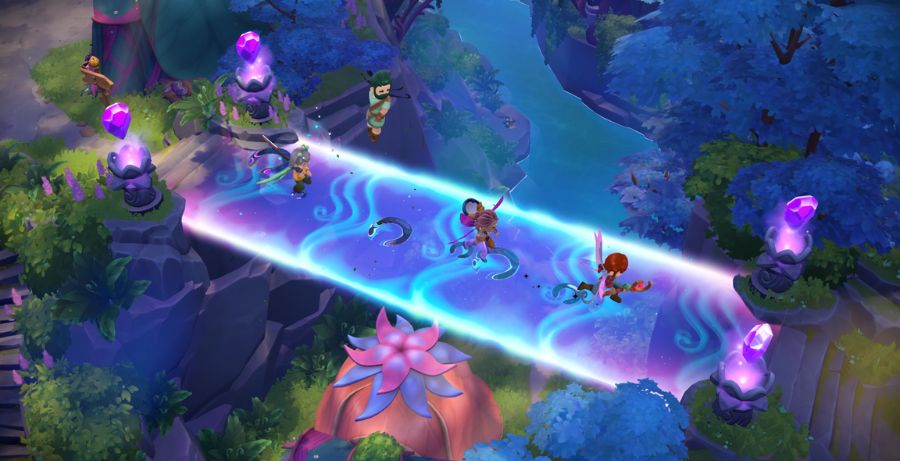
With characters defined as romanceable or friendship NPCs immediately from the start, the player is aware of what each character will mean to them as they explore relationships in the world. That presentation is a necessary exposition point for the game’s romance system. Instead of conversing with these characters and choosing options that show flirtatious interest, every interaction is taken as a flirt interaction with a character deemed romanceable. Instead of developing relationships and taking the active choice to build them into romance, Argyle is ready to date you just after talking to them three times. This led me to just avoid talking to some romanceable NPCs altogether in order to avoid starting romantic branches in the town that I didn’t want to.
That said, made by a team of around 60 developers, a simplified romance system makes sense, and once you stop judging the romance system against that of other games and let it thrive on its own, you can understand that you were given all of the tools you needed to make your relationship choices and in true player agency first fashion, you don’t have to talk to any of the romanceable characters if you don’t want and the game doesn’t lock you out of anything for it.
Taking that a step further, if you find yourself ready to move on from a relationship, you don’t have to lose your entire playthrough. Instead, divorce is just a button press in Fae Farm, and it’s the best way to balance the automatic romancing for certain NPCs. Allowing you to hit reset on a relationship allows you to explore without the stress of being locked in, and that goes a long way in a game that you can endlessly sink hours into, especially as we meet new characters through the upcoming DLCs.
The other issue that Fae Farm has to deal with is that its co-op is rough around the edges. To put it simply, if you don’t start your playthrough with your co-op partner from the start, the imbalance between progression can get overwhelming. You don’t share quests, but you do share housing and gold, and characters are locked to the world in which they were first created.
For example, if I start a character in my own world but then am invited to another person’s game, I have to recreate my character and effectively start over in order to play with them. While this is by design, it does create a gap in playability in that if you want to play the game together, you have to be aware that you can only play that specific character when the host is online, essentially splitting progress and time across two characters, which is not something I plan to do in cozy games where I’m farming and building up resources.
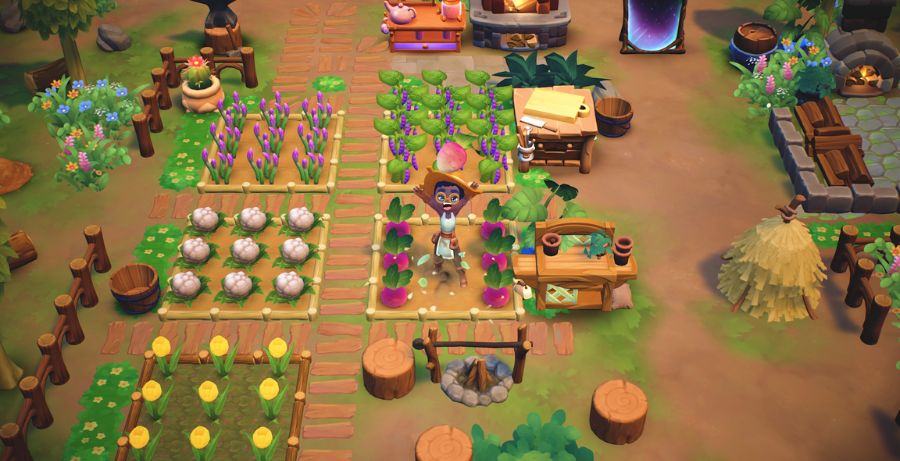
While you are able to do substantially more than in other cozy games like Animal Crossing because you share resources, housing, and money, you do actually play with a person rather than just visiting their house from your own instance. That said, The drop-in-drop-our style of play that was chosen for Fae Farm is more akin to the earlier days of co-op than what we’ve seen built out now in co-op games like Grounded, which facilitates actual cooperative play but also allows you to play unrestricted to the host’s time.
Truthfully, though, when judged only against itself and on each feature working the ways that the developers at Phoenix Labs intended, well, it’s a success. While there are some choices that aren’t my favorite iterations on things in the genre, Fae Farm is a huge, ambitious swing for a small team. There are so many systems that all work in unison to allow the player to pick the areas of cozy that they find the most engaging.
Without pushing you to necessarily engage in every one of them at one time during the short day cycle, some days you’ll invest in animal care, others in crafting and decorating your home to boost your cozy score, and others still can be sent clearing dungeons or embracing the social sim elements of the game. It’s not often that players get a game with dynamic systems that allow them to choose how to play.
Player agency is the core of Fae Farm, and achieving that is a hard feat. By building such a robust list of features and systems that look at all of the individual elements that make cozy games fun and always thinking about co-op play, Fae Farm is a success for the genre, ensuring you can get cozy in whatever way you find your peace. Cozy, dynamic, and fun, Fae Farm is well worth the many hours you’ll spend in Azoria.
Fae Farm releases on PC and Nintendo Switch September 8, 2023.
Fae Farm
-
Rating - 8/108/10
TL;DR
Cozy, dynamic, and fun, Fae Farm is well worth the many hours you’ll spend in Azoria.

